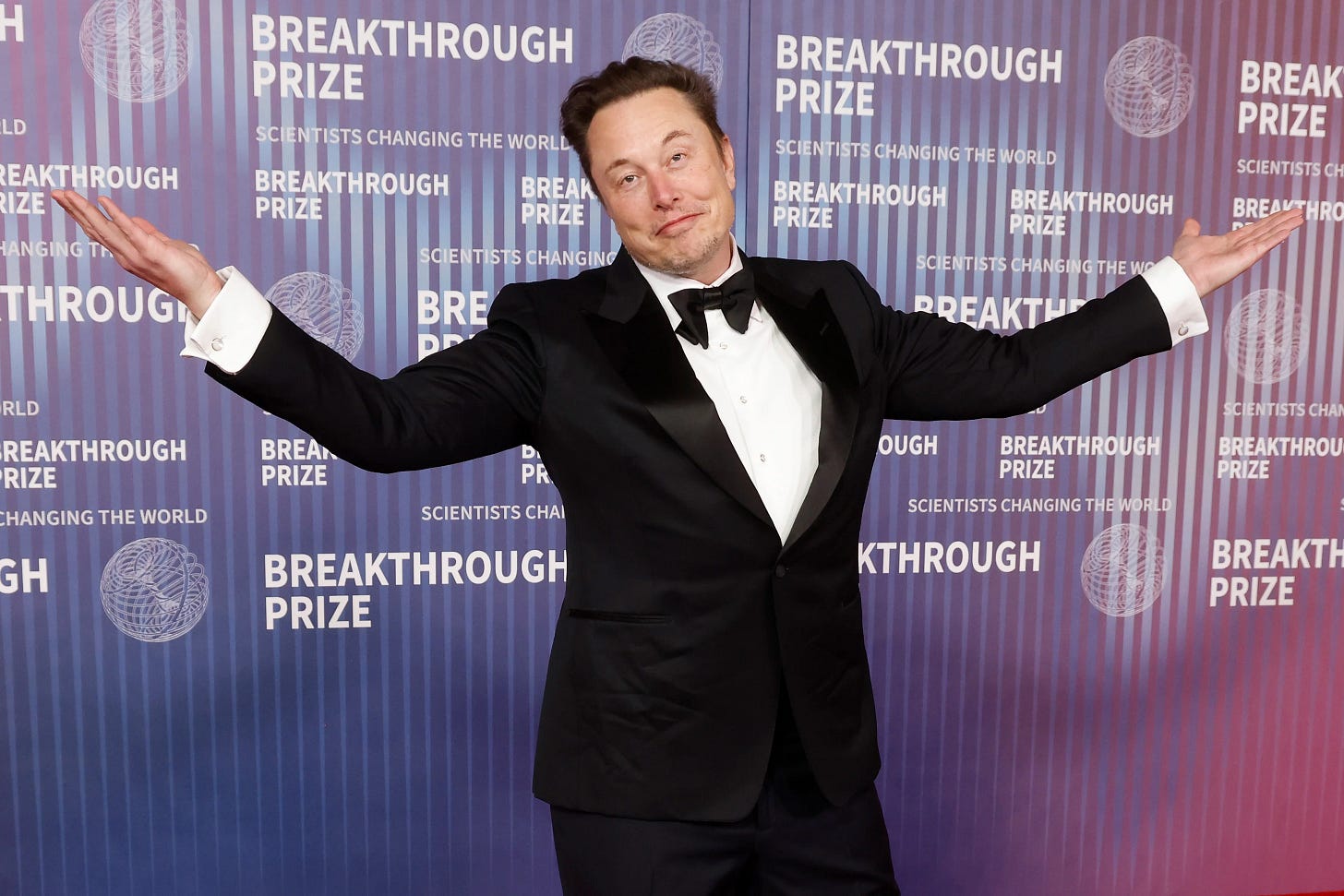Researching this piece was vexing. I poured over at least 50 reports, analyzed countless charts and graphs, and fact-checked myself into a throbbing migraine. I somehow managed to make chicken salad, but there was enough chicken shit (information) out there to fill 20 barnyards. It is, to my best judgment, an admittedly condensed but accurate account of the fledgling Department of Government Efficiency (DOGE). However, there are instances where the facts are such that weasel words such as “reported” and “intended to” were required. Many other “facts” could not be verified.
C’est la vie.
How long would it take to spend $1 billion? Theoretically speaking, of course. '
Imagine spending $1,000 a day, every day … for 2,740 years. That’s a billion dollars, with a “B.”
To get to $1 trillion (with a “T”), which is 1,000 billion … well, do the math.
Put it another way. Think of a stack of $100 bills. $1 trillion would create a pile of Franklins about 679 miles high, roughly the distance from New York City to Chicago. If you lay them end-to-end the line would be about 650,000 miles long.
Now, picture if you will U.S. government spending. Assuming a standard 365-day year for simplicity, you can calculate the daily expenditures in 2024 as follows:
Total 2024 fiscal year spending: $6.8 trillion
Days: 365
Daily spending = $6.8 trillion ÷ 365 ≈ $18.63 billion per day, every day
The numbers are mind-boggling. The trouble is that the federal government has a bad habit of spending more than it takes in. They’ve done it for a quarter of a century, and it’s been accelerating at an astonishing rate. We spend money like a Biblical flood. Since 2000, the last time the federal budget was balanced, we find ourselves $36 trillion-plus in the red.
That’s one prolonged drunken sailor binge.
The Debt
Last year, the U.S. government took in roughly $4.5 trillion (taxes, etc.) But it spent $6.8 trillion. That’s a negative $2.3 trillion, give or take a few billion. And it’s climbing an average of $1 trillion every 100 days. To make matters worse, the country spends $1.2 trillion in interest just to service the borrowing debt. That’s 125 percent of the gross domestic product.
A year-by-year review of the debt growth …
2020: $27.75 trillion (Increase: $5.03 trillion, +22.1%. Note: pandemic-related borrowing)
2021: $28.43 trillion (Increase: $0.68 trillion, +2.5%)
2022: $30.93 trillion (Increase: $2.50 trillion, +8.8%)
2023: $33.17 trillion (Increase: $2.24 trillion, +7.2%)
2024: $35.46 trillion (Increase: $2.29 trillion, +6.9%)
2025 (as of March 17): ~$36.61 trillion (estimated)
Source: Office of Management and Budget
Unsustainable.
Face it. The country is going bankrupt.
The U.S. Debt Clock
(as of 3/18/25)
(Click the image to view the live debt clock)
DOGE (Department of Government Efficiency) FAQs
Such is the daunting task of the new Department of Government Efficiency (DOGE). To clarify, there’s no officially established U.S. federal department by that name — creating a new department requires Congressional approval, which hasn’t happened.
Instead, DOGE was created by an Executive Order signed by President Trump and led by space cowboy Elon Musk, aimed at advising on government efficiency rather than functioning as a formal agency.
Here’s how the DOGE is intended to tackle federal “waste, fraud and abuse” based on available information:
Structure and Nature
Advisory Role: DOGE isn’t a traditional government department but an external advisory body or task force. Trump has described it as operating "outside of government," working alongside the White House and the Office of Management and Budget (OMB) to propose reforms.
Teams: About 20 DOGE employees work at the Eisenhower Executive Office Building. In his March 10 interview on Fox News, Musk told Larry Kudlow that DOGE had around 100 employees and planned to double his staff.
Timeline: Trump has set a July 4, 2026, deadline for DOGE to complete its work, suggesting it’s a temporary initiative rather than a permanent entity.
Goals and Objectives
Reduce Spending: Musk has claimed DOGE could cut $2 trillion from the federal budget. Targets include "wasteful expenditures," fraud and unauthorized spending.
Slash Regulations: It aims to eliminate "excess regulations" deemed burdensome to businesses and individuals.
Modernize Technology: Inspired by Musk’s tech background, it may push for updated systems to replace outdated government infrastructure. Some, like the Internal Revenue Service, are using technology that is 40 years old.
How It Operates
Recommendations, Not Authority: As a non-governmental entity, DOGE can’t directly enact changes. It has proposed cuts, reforms, and restructurings to the Trump administration, which then decides what to pursue via executive action. In a Cabinet meeting in early March, individual cabinet agencies were given authority to make decisions on personnel.
Collaboration with OMB: The OMB, which oversees the federal budget, is DOGE’s key partner. DOGE’s ideas will feed into the president’s budget proposals to Congress.
Public Engagement: Musk has promised transparency, and has indeed done so, creating the DOGE.gov website and inviting public feedback on what to cut or keep. (i.e. crowdsourcing)
Source: DOGE website
So far, DOGE has scrutinized federal contracts and grants and focused on federal workforce policies (e.g., ending remote work). It has engaged or at least made a preliminary affiance to 22 of the 451 federal agencies so far, including USAID, the Department of Education and the Department of Defense.
Mechanisms and Tools
Data Analysis: DOGE is using AI and tech-driven approaches, a Musk hallmark at SpaceX, Tesla and StarLink. Using a quantum computing process called “fractal mapping,” funds are traced from the originating source to their final destination and all the detours along the way. Fractal mapping can look backward as well as forward.
Example. An appropriation has been made to a government agency, putting money into that agency’s account. During the fiscal year, that money could be spent in 100 different ways (funding projects, programs, transfers, etc.). The number of transactions then turns into a dizzying maze of general accounts, special revenue funds, debt service funds and coded budgetary processes, so many that it becomes impossible to track the source.
Fractal mapping uses the power of quantum computing to trace these funds, something even the most robust chip-based system cannot do. It can identify the places money is spent, from origin to final destination. Fractal mapping has been equated to pulling the thread on a sweater — once you pull it the whole sweater begins to unravel.
Discoveries About Government Spending
DOGE’s discoveries are still emerging, with concrete figures and examples trickling out via the Trump administration. Here are some examples of what’s been reported or inferred by March 18, 2025:
USAID: The first and most notorious example of budgetary flummery, its $43 billion budget has been slashed dramatically and is now under the authority of the Department of State under Secretary Marco Rubio,
Improper Payments: The Government Accountability Office (GAO) reported $236 billion in improper payments for the fiscal year (FY) 2023 (ending September 30, 2023), with $175 billion as overpayments (e.g., to deceased individuals). DOGE’s February 12 hearing highlighted this as a priority, with claims of identifying “billions” in similar errors for FY 2024.
FEMA Spending: Musk alleged that FEMA spent $59 million in one week housing illegal immigrants in New York City hotels, violating a Trump executive order.
Government Credit Cards: Senator Cynthia Lummis noted DOGE found federal agencies have been issued twice as many credit cards as employees, with $40 billion in annual card spending across 4.6 million cards flagged. NOTE: There are 2.25 million federal employees.
Software Licenses: In every agency audited so far, DOGE has found there are “far more” software licenses than there are actual people in the agency. In one department, DOGE found 3,700 licenses but only 380 users.
Manual Processes: Musk highlighted a limestone mine in Pennsylvania where 700 workers process 10,000 retirement applications monthly by hand, costing undisclosed millions annually—a symbol of outdated inefficiency.
The GAO estimates $233 billion to $521 billion in annual federal fraud losses (2018-2022 data), providing a benchmark DOGE aims to tackle. However, only $109.6 billion in waste, fraud, and abuse is currently documented across 12 departments per GAO data—far short of Musk’s $2 trillion goal, suggesting deeper cuts or broader scope are still in progress.
Challenges and Limitations
No Legal Power: Without Congressional authorization, DOGE can’t force changes. Budget cuts or agency eliminations require Congressional approval, which historically resists big reductions. So Trump has used the power of Executive Order to annex government agencies and left decisions up to individual Cabinet officers to make staff cuts.
Resistance: Federal unions and agencies have pushed back against terminations and layoffs, typically in the form of lawsuits. At publishing date, more than 100 such lawsuits are pending in federal courts.
Scope: Musk’s goal of cutting $2 trillion is ambitious — major spending on Social Security, Medicare and Medicaid are politically untouchable, leaving smaller discretionary areas (15 percent of the budget) as likely targets.
Legal Concerns: While supporters praise DOGE’s aggressive cost-cutting, critics argue it risks dismantling essential services, lacks legal grounding (e.g., Musk’s unelected role), and faces lawsuits over data access and layoffs.
###
Jim Geschke was inducted into the prestigious Marquis “Who’s Who” registry in 2021.











Excellent summary and explanation—thank you!
We need to bring back secretaries. Make secretaries great again. Get rid of the robots on the phone. They are inefficient. I don’t want to listen to 5 minutes of your Privacy Policy, your Covid policy, and a bunch of Spanish before being able to making a selection that doesn’t work. I don’t want to cough and have it be interpreted as “goodbye”. I should be able to call my local post office and talk to somebody who works there and knows what’s going on. I want you in the office and answering the phone and helping grandma solve problems quickly so she can get back to watching The Price Is Right. I voted for that.